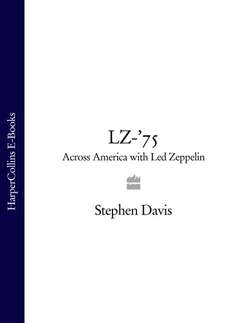Читать книгу LZ-’75: Across America with Led Zeppelin - Stephen Davis - Страница 13
CHAPTER 9 Expansive Spiritual Vistas
ОглавлениеI took a breather after two sides of Physical Graffiti. I made notes about the intense music I had heard—Led Zeppelin’s latest output, a new chapter of powerful artistry. LZ had to be the best rock band in the world now. I loved the Wailers, the Meters, and Little Feat in 1975, but to almost everyone else, Led Zeppelin was The Shit.
Would it—“rock music”—ever get any better than this?
I put on my sheepskin coat and boots and walked around the block with the dogs. It was winter in America now, and it was raining ice. Back inside, I dried the soaking dogs with old towels. I had another smoke. I made fresh tea, flipped the cassette tape, and waded into side three of Physical Graffiti.
“In the Light” was slurry and subterranean, transfused with sonic weirdness and a harmonium drone created from bowed guitars. Then it was back to Wales in 1970, with Page’s shimmering drops of summer guitar on “Bron-Yr-Aur.” Graffiti then moves forward in time with “Down by the Seaside,” from the fourth album’s sessions in 1971. “Ten Years Gone” completed the side, a melancholy ballad burst open by Page’s rapid fire in the “did you ever really need somebody” section.
On to side four. Led Zeppelin launches “Night Flight” with fiery energy, originally recorded in 1970 and left off what the fans refer to variously as Zoso, Four Symbols, and LZ IV. “The Wanton Song” was closely related to “Trampled Under Foot” and led into “Boogie with Stu,” a rumble through fifties rock with the original sixth Rolling Stone, road manager Ian Stewart, recorded in 1971. Robert Plant sang “Black Country Woman” (from the 1972 Houses of the Holy tapes: It was recorded outside in the garden of the old country house they were using as a studio) as if he were complaining about his wife. Physical Graffiti ended with a new song, “Sick Again,” whose cool, descending guitars seem to emerge from the wreckage of the Brown Bomber, LZ II.
Taking the headphones off, I was impressed by how well the band’s older material meshed with the newer songs. It told a story about a quest, an adventure that had both transcendent and carnal aspects. The story would be different for everyone who heard it. There would be millions of them, the largest audience in history. Their yearnings would be validated by this music. Their fantasies would be expressed—and respected. The amplified power of the music, its visionary themes, its intense rhythms, and its mystique-laden charm would open expansive spiritual vistas for its audience, far beyond the routines of everyday life. It was a romance, in the best sense of the romantic traditions of the West.
It will, I thought, also be interesting to hear songs like “Kashmir” and “Trampled Under Foot” performed onstage. I remembered Jimmy Page’s words from six years earlier: “If we can’t do it live, we won’t do it.”
Meanwhile, across the Atlantic Ocean, Jimmy Page caught his left hand in the sliding door of a train at Victoria Station and yelped in pain. At first he thought, with not a little relief, that he’d broken his hand, and the American tour would have to be postponed or canceled. But X-rays revealed only a badly sprained ring finger. Peter Grant pointed out that they sold out forty shows in twenty-six cities and would have to give back five million dollars if they canceled. Danny Goldberg issued a press release announcing the accident and that Jimmy was experimenting with a “three-finger fretting technique” so the shows could go on.
Flying commercial from London, Led Zeppelin arrived in Chicago on January 16, 1975, and took over an entire floor of the Ambassador Hotel, overlooking Lake Michigan. Access to the floor was monitored by two former FBI agents. The Windy City welcomed them with the coldest weather ever recorded. Veteran tour manager Richard Cole, one of rock’s greatest buccaneers, was dispatched to buy the heaviest fur coats available, but not before Robert Plant’s persistent sniffle turned into a cold. Robert’s illness was attended by a new member of Zeppelin’s entourage, a handsome young doctor who had previously worked for the Rolling Stones and other bands. The doctor carried two large medical cases and was reportedly prepared to treat anything from overdoses to gunshots to homesickness. “Worth his weight in gold,” Jimmy Page said later.
The next day, Led Zeppelin flew their chartered jet to Minneapolis, where they spent the evening rehearsing in the cavernous Met Center. They opened the tour the next evening, January 18, with a Saturday night concert that was, Robert Plant apologetically admitted to the kids ($8.50 per ticket), “a bit rusty.” The opener, the thunderous “Rock and Roll,” was the usual Zeppelin blastoff, but Robert’s voice was strained because his cold was getting worse. “Dazed and Confused” was cut from the set because of Page’s injury, but Jimmy managed to deliver some sensational blues improvisations that drew loud applause. John Bonham played his drum solo, “Moby Dick,” for fifteen minutes. When the band walked off, after two and a quarter hours, and the houselights came on, the kids (who expected a three-hour show) stood and booed for as long as “Moby Dick” had lasted.
Somewhat dispirited, with the tour doctor unnerved because Robert wasn’t responding to treatment and felt horrible, Led Zeppelin boarded its Starship and flew back to Chicago in bone-chilling, subzero weather.
